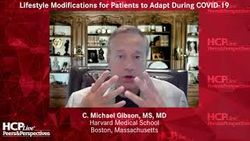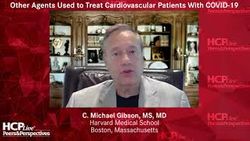Reducing Cardiovascular Risks During COVID-19 - Episode 7
Treating Cardiovascular Risks in Patients Tested for COVID-19
Transcript:
Deepak Bhatt, MD, MPH: A number of folks have reported it, and I’ve seen a couple of cases too where it’s mechanical complications from ACS [acute coronary syndromes], acute MI [myocardial infarction], and STEMI [ST-elevation myocardial infarction] that haven’t been seen in this proportion perhaps since the lytic era.
C. Michael Gibson, MS, MD: Yeah.
Deepak Bhatt, MD, MPH: I don’t know if you’ve been seeing that as well with the BI [Beth Israel Deaconess Medical Center], but we certainly have had our share of mechanical complications in greater proportion than we’ve seen in ages at the Brigham and Women’s Hospital.
C. Michael Gibson, MS, MD: Certainly. I’m reading all about that everywhere. I can’t say that’s been a huge problem at our hospital because there is a small sample size at this point. The other issue, Deepak, is that some people just aren’t coming in, period. There’s been a 40% reduction in the number of STEMI [ST-elevation myocardial infarction] patients presenting in most of the world, and they may be dying at home. When you read about COVID-19 [coronavirus disease 2019] mortality, we always ask, “Are they counting the people who died at home who didn’t come in because of their MI [myocardial infarction]?” This may not be directly attributable to the infection, but it’s certainly attributable to the pandemic, and it has probably caused a lot more deaths than we realize.
Deepak Bhatt, MD, MPH: I completely agree. You mentioned MI. You mentioned PE [pulmonary embolism], of course DVT [deep vein thrombosis] going along with the PE in many cases. Acute stroke has also been a big problem, including in people who are relatively young. Proportionally, the rate is still rather low, but it’s quite devastating when a young person has an ischemic stroke or a thromboembolic stroke or requires an amputation, so there have been a variety of atherothrombotic manifestations, even beyond the heart. The cumulative morbidity and mortality is pretty high, in some cases also involving younger folks. It’s such a spectrum of cardiovascular disease we’re seeing here. It’s perhaps what people experienced in older days when they were first discovering syphilis and all the sorts of different things it did to various parts of the body.
I was in New York when HIV first came on the scene, and I remember in the hospitals uncertainty, fear, and that sort of thing. This seems to be on a totally different scale. When we were in Boston—where we both are, of course—and the surge occurred, I’ve never experienced anything like that in health care. Yes, there was fear in New York. I remember when HIV was coming out, and we were all worried, “Might we catch this infection?” There was concern even just among health care workers about whether they were putting themselves or family members at risk. The scale of this was just overwhelming when the surge was occurring.
C. Michael Gibson, MS, MD: There’s the overwhelming part during the surge, but all these people are possibly going to be walking wounded. The long-term neurocognitive effects aren’t well understood. A substantial proportion of people have a lot of confusion and cognitive decline. It’s not clear what’s going to happen over the long term with all them. This could be the tip of the iceberg, the acute effect. I’m worried about the long-term cognitive effect from a lot of this.
Deepak Bhatt, MD, MPH: I agree. There are all sorts of potential neurological damages that may be permanent: pulmonary damage in some folks that may be permanent and cardiac damage.
C. Michael Gibson, MS, MD: Yes.
Deepak Bhatt, MD, MPH: A small percentage of patients, it appears, are troponin positive. They have a much higher rate of mortality. Among those who survive the hospital discharge, at least some proportion may have elevated cardiovascular risk that is even beyond what risk they came into the hospital with. There’s a lot we don’t know on the back end in terms of COVID-19 survivors and what’s in store for them. At a minimum, we’ve got to make sure whatever cardiovascular risks those patients with COVID-19–positive discharge had, we treat them as we normally would: in a guideline-appropriate way or perhaps even more aggressively.
C. Michael Gibson, MS, MD: Absolutely. Just because it was a type 2 MI or it was heart rate related or something, that doesn’t mean we shouldn’t be aggressive with them as well. You’re right, Deepak. Use a pretty good antiplatelet approach, statins obviously, as always. There are some conflicting data. There are some original preliminary data on statins and COVID-19. They’re nonrandomized data; I don’t think we have any good randomized data. You may know of some, but that could turn out to be important as well.
Deepak Bhatt, MD, MPH: No. All I know is the observational data, some of which shows that statins are associated with better outcomes. Of course, there can always be potential for confounding variables. There have been several statins studies through the years that have found serious connections with things like benefits on cancer, fractures, or other sorts of things. I’d be cautious about getting too excited about any of that in terms of statins and direct effects on COVID-19.
On the other hand, if someone is at elevated cardiovascular risk and should have been on a statin anyway, then they should be on a statin even more if they’ve got COVID-19 and survived it. If anything, it’s not going to have reduced their cardiovascular risk if they’ve had COVID-19. It might only potentially increase it. I agree with you. If they should be on blood pressure medicines, make sure they are. It’s the same with statins, and it’s the same with appropriate degrees of glycemic control. Just make sure that all the guidelines are being applied in those COVID-19–positive patients.
C. Michael Gibson, MS, MD: In terms of research, Deepak, you can give antiplatelets, but if this is endothelial disruption with von Willebrand factor exposure, there is a class of agents that’s being developed, the von Willebrand factor inhibitors, that could be quite good at preventing that. If the platelet has its tail hook on and lands on the endothelium where von Willebrand factor is, if you inhibit that, you might prevent that initial propagation of clots. Who knows? A lot of the time, these health outbreaks provide the momentum and stimulus for us to have some new classes of drugs. Maybe something good will come out of this.
Deepak Bhatt, MD, MPH: I’ve always thought that potential mechanism of action could be the Holy Grail we’re looking for: the so-called free lunch that Dr Eugene Braunwald had taught us about. He, of course, said that there is no free lunch when it comes to antithrombotic agents. There’s always bleeding. There’s always been this theory that things may be working more locally in terms of platelet adhesion, so you could get the best of both worlds: preventing thrombosis due to endothelial injury, say from cigarette smoking or hypercholesterolemia, without causing an excess of systemic bleeding. You’re right. Maybe those sorts of compounds and the opportunity to test them now because of the COVID-19 pandemic might lend insights that are useful even post-COVID-19 pandemic.
C. Michael Gibson, MS, MD: We’re always looking for the magic bullet that prevents thrombosis and allows hemostasis, so that might be 1 of those bullets.
Transcript Edited for Clarity


